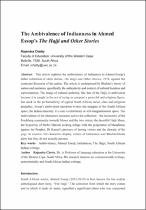| dc.contributor.author | Chetty, Rajendra | |
| dc.date.accessioned | 2022-07-27T07:59:03Z | |
| dc.date.available | 2022-07-27T07:59:03Z | |
| dc.date.issued | 2021 | |
| dc.identifier.citation | Chetty, R. (2021). The Ambivalence of Indianness in Ahmed Essop's The Hajji and Other Stories. Forum for World Literature Studies, 13(1), 72+. https://link.gale.com/apps/doc/A661822858/AONE?u=anon~75088cc3&sid=googleScholar&xid=941c267c | en_US |
| dc.identifier.issn | 2154 6711 | |
| dc.identifier.uri | https://link.gale.com/apps/doc/A661822858/AONE?u=anon~75088cc3&sid=googleScholar&xid=941c267c | |
| dc.identifier.uri | http://hdl.handle.net/10566/7636 | |
| dc.description.abstract | This article explores the ambivalence of Indianness in Ahmed Essop’s
debut collection of short stories, The Hajji and Other Stories, 1978, against the
contested discourse of the nation. The article is underpinned by Bhabha’s theory of
nation and narration, specifically the authenticity and context of cultural location and
representation. The image of cultural authority, like that of the Hajji, is ambivalent
because it is caught in the act of trying to compose a powerful and religious figure,
but stuck in the performativity of typical South African racial, class and religious
prejudice. Essop’s ambivalent narration evokes the margins of the South African
space, the Indian minority; it is also a celebratory or self-marginalisation space. The
ambivalence of the characters resonates across the collection—the insincerity of the
Fordsburg community towards Moses and the two sisters; the deceitful Hajji Musa,
the hypocrisy of Molvi Haroon seeking refuge with the perpetrator of blasphemy
against the Prophet, Dr Kamal’s pretence of having virtues and the charade of the
yogi. In essence, the characters display virtues of Indianness and Muslim/Hindu
piety that they do not actually possess. | en_US |
| dc.language.iso | en | en_US |
| dc.subject | Ambivalence | en_US |
| dc.subject | Ahmed Essop | en_US |
| dc.subject | Indianness | en_US |
| dc.subject | The Hajji | en_US |
| dc.subject | South African Indian writings | en_US |
| dc.title | The Ambivalence of Indianness in Ahmed Essop’s The Hajji and Other Stories | en_US |
| dc.type | Article | en_US |

